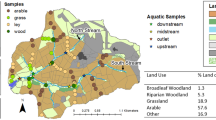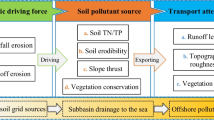Abstract
An efficient linear Kalman filter has been combined with a coupled atmospheric transport and soil–air exchange model to determine organochlorine pesticides emissions on the regional scale. In this study, results of γ-HCH emissions from the Great Lakes–St. Lawrence ecosystem, estimated from the coupled model, are presented and discussed. A source receptor technique is used to identify a priori the locations of emission sources of γ-HCH, the emissions are then updated through a Kalman filtering procedure which minimizes the weighted difference between the predicted mixing ratios from the coupled model and the measured concentrations over the Great Lakes–St. Lawrence river region. Two experiments using the inverse algorithm are carried out. In the first experiment, the coupled atmospheric transport and soil–air exchange model is implemented to predict γ-HCH air and soil concentrations. Emissions are then updated every 12 days using the updated soil concentrations and emission factors. However, the updated emissions are not input into the coupled atmospheric transport and soil–air exchange model. On the other hand, in the second experiment the updated emissions are fed back to the coupled model, so that the model is reinitialized in each 12 days. The results from the inverse technique for the year 1995 have been compared with grided γ-HCH emission inventory in Canada, generated by emission factors. It is shown that the estimated emissions of γ-HCH are consistent with the measured emissions. It is found that the St. Lawrence valley has larger emissions of γ-HCH than the Great Lakes region, indicating an opposite distribution to the emission usage inventory, but in agreement with the measured γ-HCH concentration.
Similar content being viewed by others
References
K.L. Willett, M.F. Ulrich and R.A. Hites, Differential toxicity and environmental fates of hexachlorocyclohexane isomers, Environ. Sci. Technol. 32 (1998) 2197-2207.
L.L. McMonnel, W.E. Cotham and T.F. Bidleman, Gas exchange of hexachlorocyclohexanes in the Great Lakes, Environ. Sci. Technol. 27 (1993) 1304-1311.
A.G. Smith, Chlorinated hydrocarbon insecticides, classes of pesticides, in: Handbook of Pesticide Toxicology, eds. W.J. Hayes and E.R. Laws (Academic Press, San Diego, CA, 1991) pp. 731-915.
G.M. Woodwell, P.P. Craig and H.A. Johnson, DDT in the biosphere: Where does it go?, Science 174 (1971) 1101-1107.
L.A. Barrie, D. Gregor, B. Hargrave, R. Lake, D. Muir, R. Shearer, B. Tracy and T. Bidleman, Arctic contaminants: Sources, occurrences and pathways, Sci. Total Environ. 28 (1994) 213-225.
T.F. Bidleman, L.M. Jantunen, R.L. Falconer, L.A. Barrie and P. Fellin, Decline of hexachlorocyclohexane in the Arctic atmosphere and reversal of air-sea gas exchange, Geophys. Res. Lett. 22 (1995) 219-222.
Y.F. Li, T.F. Bidleman, L.A. Barrie and L.L. McConnell, Global hexachlorocyclohexane use trends and their impact on the arctic atmospheric environment, Geophys. Res. Lett. 25 (1998) 39-41.
D.A. Hinckley, T.F. Bidleman and C.P. Rice, Atmospheric organochlorine pollutants and air-sea exchange of hexachlorocyclohexane in the Bering and Chukchi Seas, Geophys. Res. Lett. 96c (1991) 7201-7213.
M. Kawano, T. Inoue, T. Wada, H. Hidaka and R. Tatsukawa, Bioconcentration and residue patterns of chlordane compounds in marine animals: Invertebrates, fish, mammals and seabirds, Environ. Sci. Technol. 22 (1988) 792-797.
Y.F. Li, M.T. Scholtz and B.J. van Heyst, Global gridded emission inventories of ?-hexachlorocyclohexane, J. Geophys. Res. 105/D5 (2000) 6621-6632.
M. Scholtz, A.C. McMillan, D. Slama, Y.F. Li, N. Ting and K. Davidson, Pesticide emissions modeling: Development of a North American pesticide emissions inventory, in: Rep. CGEIC-1997-1 (Canadian Global Interpretation Cent., Toronto, Ont., 1997) pp. 1-242.
D.T.Waite, A.J. Cessna, N.P. Gurprasad and J. Banner, A new sampler for collecting separate dry and wet atmospheric depositions of trace organic chemicals, Atmos. Environ. 33 (1999) 1513-1523.
L. Poissant and J.F. Koprivnjak, Fate and atmospheric concentrations of ?-and ?-hexachlorocyclohexanr in Québec, Canada, Environ. Sci. Technol. 30 (1996) 845-851.
L. Robertson and C. Persson, On the application of four dimensional data assimilation of air pollution data using the adjoint technique, in: Air Pollution Modeling & Its Application IX, eds. H. von Dop and G. Kallos (Plenum Press, New York, 1992) pp. 365-373.
D. Hartley and R. Prinn, Feasibility of determining surface emissions of trace gases using the inverse method in a three-dimensional chemical transport model, J. Geophys. Res. 98 (1993) 5183-5197.
X. Zhang, Data assimilation in air pollution modeling, PhD thesis (1996) pp. 1-171.
J. Pudykiewicz, Application of adjoint tracer transport equations for evaluating source parameters, Atmos. Environ. 32 (1998) 3039-3050.
M. Verlaan, Efficient Kalman filtering algorithms for hydrodynamic models, PhD thesis (1998) pp. 1-201.
J.F. Koprivnjak and L. Poissant, Evaluation and application of a fugacity model to explain the partitioning of contaminations in the St. Lawrence river valley, Water, Air, and Soil Pollut. 97 (1997) 379-395.
J. Ma, Users guide: A regional scale atmospheric transport model for heavy metal and pesticide deposition, Rep. 1-km062-8-6509 to ARQI (2000) pp. 1-36.
W.W. Brubaker and R.A. Hites, OH reaction kinetics of gas-phase ?-and ?-hexachlorocyclohexane and hexachlorobenzene, Environ. Sci. Technol. 32 (1998) 766-769.
J. Ma and S.M. Daggupaty, Stability dependence of height scales and effective roughness lengths of momentum and heat transfer over roughness changes, Bound.-Layer Meteorol. 88 (1998) 145-160.
J. Ma and S.M. Daggputy, Effective deposition velocities for gases and particles over heterogeneous terrain, J. Appl. Meteorol. 39 (2000) 1379-1390.
M. Verlaan and A.W. Heemink, Data assimilation schemes for nonlinear shallow water flow models, in: Proc. of Second International Symposium on Assimilation of Observations (WMO, Tokyo, Japan, 1995) pp. 247-252.
A.W. Heemink, M. Verlaan and A.J. Segers, Variance reduced ensemble Kalman filtering, Mon. Wea. Rev. 129 (2001) 1718-1728.
T. Harner, T.F. Bidleman, L.M.M. Jantunen and D. Mackay, Air-soil exchange model of persistent pesticides in the U.S. cotton belt, Environ. Tox. Chem. 20 (2001) 1612-1621.
D. Mackay, Multimedia Environmental Models (Lewis, Chelsea, MI, USA, 1991).
F. Wania and D. Mackay, A global distribution model for persistent organic chemicals, Sci. Total Environ. 160/161 (1995) 211-232.
P.S. Liss and P.G. Slater, Flux of gases across the air-sea interface, Nature 247 (1974) 181-184.
E. Atlas and C.S. Giam, Ambient concentration and precipitation scavenging of atmospheric organic pollutants, Water, Air and Soil Pollut. 38 (1988) 19-36.
Y.F. Li, A. McMillan and M.T. Scholtz, Global HCH usage with 1? x 1? longitude and latitude resolution, Environ. Sci. Technol. 30 (1996) 3525-3533.
R.M. Hoff et al., Atmospheric deposition of toxic chemicals to the Great Lakes: a review of data through 1994, Atmos. Environ. 30 (1996) 3505-3727.
Author information
Authors and Affiliations
Rights and permissions
About this article
Cite this article
Ma, J., Li, Yf. & Poissant, L. Estimation of Emissions of γ-Hexachlorcyclohexane from the Great Lakes–St. Lawrence Ecosystem Using a Coupled Efficient Kalman Filter–Atmospheric Transport–Soil Model. Environmental Modeling & Assessment 8, 71–84 (2003). https://doi.org/10.1023/A:1023961617159
Issue Date:
DOI: https://doi.org/10.1023/A:1023961617159




